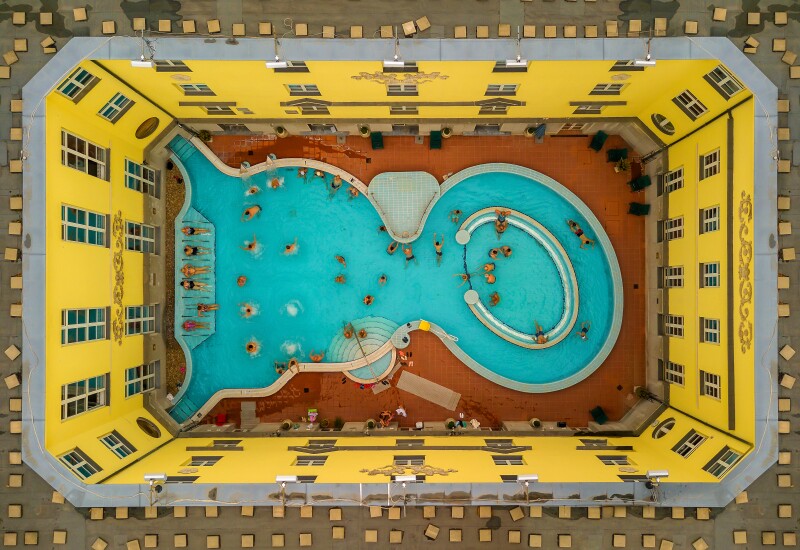Budapest is known as the City of Spas for a reason. It boasts more thermal and medicinal water springs than any other capital in the world. The original Roman baths live on as archaeological sites, but travelers can still take their pick from celebrated spas from across the centuries, including hammam-style baths from the 150-year Ottoman occupation and grand Beaux-Arts bathing palaces. While most spas tout their healing properties—their water may contain minerals, such as calcium, magnesium, and sodium, that studies have shown to be therapeutic for some ailments—soaking is largely a social affair and an essential part of Budapest’s rich culture.
To enjoy a truly local experience and fewer crowds, go to the more popular baths when they open or in the evening if they stay open late. Most of the baths in Budapest offer a series of indoor and outdoor thermal pools that range from warm to hot (work your way up in temperature while relaxing and cooling off in between), as well as saunas, steam rooms, icy plunge pools, and other distinctive amenities.
Bring along your swimsuit, a towel, flip-flops (floors can get slippery), and any personal products you like to have after a swim. Swimming caps must be worn by those using the lap pool. Most baths also rent or sell these items if you need them in a pinch. Keep reading for a few of the top baths in the city where you can take the plunge.
Care for yourself at Gellért Baths

Gellért Baths
Courtesy of Visit Hungary
A stylish example of Budapest’s vibrant 19th-century bathing culture, the Gellért Baths attract bathers with their art nouveau-style Zsolnay porcelain tiles, turquoise walls, and stained-glass windows. Built in 1918 as part of the stately Hotel Gellért, they’re still considered a symbol of comfort. A well-heeled crowd—including celebrities such as Richard Nixon, Jane Fonda, and Ryan Gosling—has been basking under the vaulted ceilings for more than 100 years.
Soak up the glamorous atmosphere while taking a dip in the thermal pools and relaxing on the sunbathing terrace with a glass of champagne in hand. Some of the smaller baths can even be booked privately, making it an excellent choice for couples.
Explore Széchenyi Thermal Bath

Széchenyi Thermal Bath // Courtesy of Visit Hungary
Courtesy of Visit Hungary
Budapest’s most popular thermal bath among locals and tourists alike, Széchenyi Thermal Bath also ranks as the largest spa complex in Hungary (and one of the biggest in all of Europe). It’s home to three large outdoor hot spring pools, 11 indoor thermal baths, one indoor cooling pool, one indoor immersion pool, an outdoor swimming pool, an outdoor activity pool, 10 saunas at various temperatures, and a menu of wellness and fitness services that’s too long to list.
For the full experience, wake up early and head to the outdoor section, surrounded by a stunning, yellow neo-Baroque palace built in 1913, and watch old men play chess in the water. Fully open throughout the year, soaking in the warm waters of Széchenyi makes an excellent—and quintessentially Hungarian—wintertime activity.
Enjoy the view at Rudas Thermal Bath

Rudas Thermal Bath
Courtesy of Visit Hungary
Located at the Buda end of Erzsébet Bridge, Rudas Thermal Bath has been welcoming bathers for upwards of 450 years since the Turkish conquest of Hungary. A hammam-type bath, Rudas’ six pools are filled with water at different temperatures.
The only spot that still features traditional, same-sex bathing, Rudas separates genders on weekdays and offers coed bathing on weekends. A rooftop thermal water jacuzzi is always available for everyone to relax and enjoy panoramic views of Budapest, even in wintertime.
Immerse yourself in history at Veli Bej

Veli Bej
Courtesy of Visit Hungary
Built in the 16th century, Veli Bej recently underwent a renovation to upgrade its spa facilities. The Ottoman-era Turkish bathhouse, which was closed to the public for decades, has now regained its original splendor. (An on-site exhibition highlights archaeological finds discovered during the facelift).
Refitted with two steam chambers with massage showers and an ice machine, plus a Jacuzzi, Kneipp walk pool, swimming pool, and Finnish and infrared sauna, Veli Bej’s medicinal waters have become an ideal destination for those struggling with rheumatic symptoms, as well as anyone simply wanting to relax. A smaller bath that’s accessible from a hospital, it’s an off-the-beaten-path gem for travelers who prefer a more intimate spa experience.
Experience the healing power of Szent Lukács Bath

Szent Lukács Bath
Courtesy of Visit Hungary
Found near Margaret Bridge on the Buda side, Szent Lukács Bath has a reputation for the healing properties of its waters—and even for making miracles happen. Walk along the park leading to the bath building to read the many Gratitude Tablets or stone plaques on its walls, dating to the 1890s that express thanks for the wondrous effect of the bath’s water.
Szent Lukács is also known for its specialty treatments and departments, such as the Himalayan Salt Room for curing respiratory problems, or the Weight Bath used for stretching the back and spinal injuries. Until recently, this thermal bath was exclusively used by locals but has become more popular with travelers looking for a standout experience. Enjoy one or more of the many different massage services, then grab a sunbed and relax outside.











